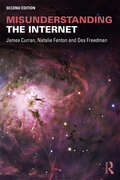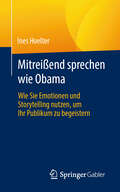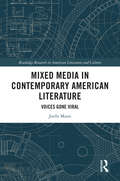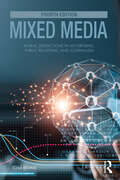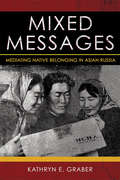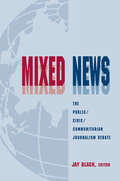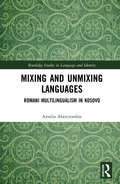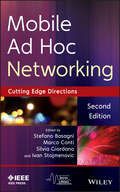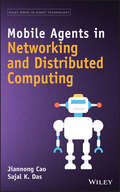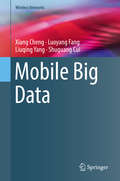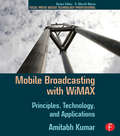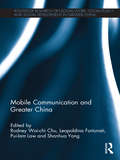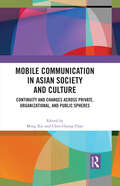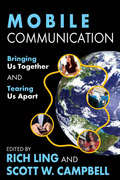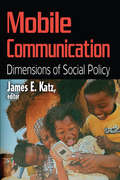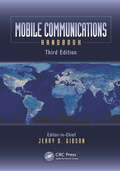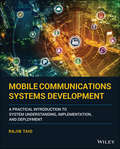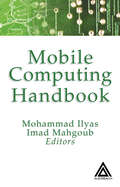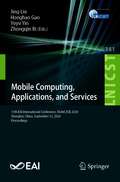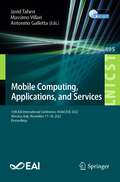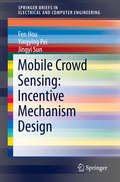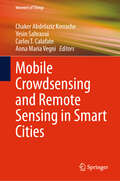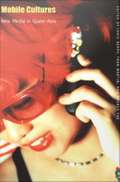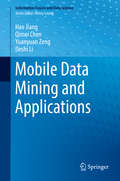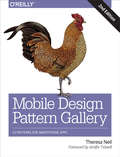- Table View
- List View
Misunderstanding the Internet (Communication and Society)
by James Curran Des Freedman Natalie FentonThe growth of the internet has been spectacular. There are now more than 3 billion internet users across the globe, some 40 per cent of the world’s population. The internet’s meteoric rise is a phenomenon of enormous significance for the economic, political and social life of contemporary societies. However, much popular and academic writing about the internet continues to take a celebratory view, assuming that the internet’s potential will be realised in essentially positive and transformative ways. This was especially true in the euphoric moment of the mid-1990s, when many commentators wrote about the internet with awe and wonderment. While this moment may be over, its underlying technocentrism – the belief that technology determines outcomes – lingers on and, with it, a failure to understand the internet in its social, economic and political contexts. Misunderstanding the Internet is a short introduction, encompassing the history, sociology, politics and economics of the internet and its impact on society. This expanded and updated second edition is a polemical, sociologically and historically informed guide to the key claims that have been made about the online world. It aims to challenge both popular myths and existing academic orthodoxies that surround the internet.
Mitreißend sprechen wie Obama: Wie Sie Emotionen und Storytelling nutzen, um Ihr Publikum zu begeistern
by Inés HoelterDieses Buch zeigt, wie Sie im Beruf authentisch sprechen und Menschen überzeugen – gerade dann, wenn es wirklich drauf ankommt. Inés Hoelter, renommierte Sprechtrainerin und Medienprofi, beschreibt anschaulich, wie durch Sprechduktus und die begleitende Gestik Emotionen erzeugt werden, die ZuhörerInnen mitreißen. Vom klassischen Aufbau einer guten Rede bis hin zur Bedeutung von Storytelling und der Heldenreise lernen Sie die Basics der perfekten Perfomance kennen. Darüber hinaus erläutert die Autorin anhand neurowissenschaftlicher Erkenntnisse, warum bestimmte Taktiken besser wirken als andere und warum manche Reden in den Köpfen der Zuhörer besonders lange nachhallen. Ein Muss für alle, die mit ihrer Performance im Konferenzraum oder auf der Bühne in die nächste Liga aufsteigen wollen.
Mixed Media in Contemporary American Literature: Voices Gone Viral (Routledge Research in American Literature and Culture)
by Joelle MannMixed Media in Contemporary American Literature: Voices Gone Viral investigates the formation and formulation of the contemporary novel through a historical analysis of voice studies and media studies. After situating research through voices of nineteenth- and twentieth-century American literature, this book examines the expressions of a multi-media vocality, examining the interactions among cultural polemics, aesthetic forms, and changing media in the twenty-first century. The novel studies shown here trace the ways in which the viral aesthetics of the contemporary novel move language out of context, recontextualizing human testimony by galvanizing mixed media forms that shape contemporary literature in our age of networks. Through readings of American authors such as Claudia Rankine, David Foster Wallace, Jennifer Egan, Junot Díaz, Michael Chabon, Joseph O’Neill, Michael Cunningham, and Colum McCann, the book considers how voice acts as a site where identities combine, conform, and are questioned relationally. By listening to and tracing the spoken and unspoken voices of the novel, the author identifies a politics of listening and speaking in our mediated, informational society.
Mixed Media: Moral Distinctions in Advertising, Public Relations, and Journalism
by Tom Bivins Thomas BivinsMixed Media offers students of journalism, advertising, and public relations the tools for making ethical and moral decisions within their professional disciplines. The fourth edition of this popular text features more recent ethical theories that acknowledge and address intersectionality within the communicative landscape, including issues of gender, race, ability, and age. The author also takes into account today’s rapidly expanding technology, touching on subjects such as free speech, censorship, cancel culture, and misinformation, and considers how each of these is affected by online and social media. Other updates to the text include expanded coverage of citizen journalism, the increasing media use of artificial intelligence and virtual reality, power in communicative structures, and public interest, as well as refreshed examples throughout. As in previous editions of the book, special attention is paid to key ethical decision-making approaches and concerns in each media industry, including but not limited to truth telling, constituent obligations, persuasion versus advocacy, and respect for the consumers of public communication. Mixed Media is key reading for students of all branches of Media and Communication Ethics. The author's own website, featuring lecture notes, case studies and links to further reading, can be accessed at www.j397mediaethics.weebly.com.
Mixed Messages: Mediating Native Belonging in Asian Russia
by Kathryn E. GraberFocusing on language and media in Asian Russia, particularly in Buryat territories, Mixed Messages engages debates about the role of minority media in society, alternative visions of modernity, and the impact of media on everyday language use. Graber demonstrates that language and the production, circulation, and consumption of media are practices by which residents of the region perform and negotiate competing possible identities. What languages should be used in newspapers, magazines, or radio and television broadcasts? Who should produce them? What kinds of publics are and are not possible through media? How exactly do discourses move into, out of, and through the media to affect everyday social practices? Mixed Messages addresses these questions through a rich ethnography of the Russian Federation's Buryat territories, a multilingual and multiethnic region on the Mongolian border with a complex relationship to both Europe and Asia.Mixed Messages shows that belonging in Asian Russia is a dynamic process that one cannot capture analytically by using straightforward categories of ethnolinguistic identity.
Mixed News: The Public/civic/communitarian Journalism Debate (Routledge Communication Series)
by Jay BlackThis volume addresses some of the central issues of journalism today -- the nature and needs of the individual versus the nature and needs of the broader society; theories of communitarianism versus Enlightenment liberalism; independence versus interdependence (vs. co-dependency); negative versus positive freedoms; Constitutional mandates versus marketplace mandates; universal ethical issues versus situational and/or professional values; traditional values versus information age values; ethics of management versus ethics of worker bees; commitment and compassion versus detachment and professional "distance;" conflicts of interest versus conflicted disinterest; and "talking to" versus "talking with." All of these issues are discussed within the framework of the frenetic field of daily journalism--a field that operates at a pace and under a set of professional standards that all but preclude careful, systematic examinations of its own rituals and practices. The explorations presented here not only advance the enterprise, but also help student and professional observers to work through some of the most perplexing dilemmas to have faced the news media and public in recent times. This lively volume showcases the differing opinions of journalistic experts on this significant contemporary issue in public life. Unlike previous books and monographs which have tended toward unbridled enthusiasm about public journalism, and trade press articles which have tended toward pessimism, this book offers strong voices on several sides of this complex debate. To help inform the debate, a series of "voices"--journalistic interviews with practitioners and critics of public journalism -- is interspersed throughout the text. At the end of each essay, a series of quotes from a wide variety of sources -- "In other words..." -- augments each chapter with ideas and insights that support and contradict the points used by each chapter author.
Mixing and Unmixing Languages: Romani Multilingualism in Kosovo (Routledge Studies in Language and Identity)
by Amelia AbercrombieMixing and Unmixing Languages uses the politics and practices of language to understand social hierarchies and social change in a post-conflict and post-socialist context. The book focuses on Roma in Prizren, Kosovo, where the author conducted long-term ethnographic fieldwork, using language learning as a central method. Shifts in language practices among this highly multilingual group have reflected the demise of Yugoslav socialism, the rise of ethno-nationalist politics and conflict, and the post-war reversal of power relations in Kosovo. Roma in Prizren nostalgically narrate a past of cosmopolitanism and employment in contrast to the present. Their position today is complex: while they stress their relative integration, this position is fragile in the face of nationalist politics and imported neoliberal economic policies. Within this context, Roma NGO workers have found an economic niche working on projects to protect multiculturalism and minorities, funded by international aid agencies, centred on Romani language. This book discusses the historical trajectory and current configurations of a Romani organisation in the town, the standardisation of Romani and the hierarchical organisation of linguistic forms and language learning, the self-representation of Roma and the ‘gypsy’ image through Romani-language drama, and attitudes to purism, mixing and cosmopolitanism. Mixing and Unmixing Languages is suitable for academics and students in the areas of linguistic anthropology and linguistic ethnography, Romani studies, South-East European studies and sociolinguistics.
Mobile Ad Hoc Networking
by Ivan Stojmenovic Marco Conti Stefano Basagni Silvia Giordano"An excellent book for those who are interested in learning the current status of research and development . . . [and] who want to get a comprehensive overview of the current state-of-the-art."--E-StreamsThis book provides up-to-date information on research and development in the rapidly growing area of networks based on the multihop ad hoc networking paradigm. It reviews all classes of networks that have successfully adopted this paradigm, pointing out how they penetrated the mass market and sparked breakthrough research.Covering both physical issues and applications, Mobile Ad Hoc Networking: Cutting Edge Directions offers useful tools for professionals and researchers in diverse areas wishing tolearn about the latest trends in sensor, actuator, and robot networking, mesh networks, delay tolerant and opportunistic networking, and vehicular networks.Chapter coverage includes:Multihop ad hoc networkingEnabling technologies and standards for mobile multihop wireless networkingResource optimization in multiradio multichannel wireless mesh networksQoS in mesh networksRouting and data dissemination in opportunistic networksTask farming in crowd computingMobility models, topology, and simulations in VANETMAC protocols for VANETWireless sensor networks with energy harvesting nodesRobot-assisted wireless sensor networks: recent applications and future challengesAdvances in underwater acoustic networkingSecurity in wireless ad hoc networksMobile Ad Hoc Networking will appeal to researchers, developers, and students interested in computer science, electrical engineering, and telecommunications.
Mobile Agents in Networking and Distributed Computing
by Sajal K. Das Jiannong CaoThe book focuses on mobile agents, which are computer programs that can autonomously migrate between network sites. This text introduces the concepts and principles of mobile agents, provides an overview of mobile agent technology, and focuses on applications in networking and distributed computing.
Mobile Big Data (Wireless Networks)
by Shuguang Cui Liuqing Yang Xiang Cheng Luoyang FangThis book provides a comprehensive picture of mobile big data starting from data sources to mobile data driven applications. Mobile Big Data comprises two main components: an overview of mobile big data, and the case studies based on real-world data recently collected by one of the largest mobile network carriers in China. In the first component, four areas of mobile big data life cycle are surveyed: data source and collection, transmission, computing platform and applications. In the second component, two case studies are provided, based on the signaling data collected in the cellular core network in terms of subscriber privacy evaluation and demand forecasting for network management. These cases respectively give a vivid demonstration of what mobile big data looks like, and how it can be analyzed and mined to generate useful and meaningful information and knowledge. This book targets researchers, practitioners and professors relevant to this field. Advanced-level students studying computer science and electrical engineering will also be interested in this book as supplemental reading.
Mobile Broadcasting with WiMAX: Principles, Technology, and Applications (Focal Press Media Technology Professional Ser.)
by Amitabh KumarWritten exclusively from broadcasters perspective, Mobile Broadcasting with WiMAX will help you move ahead in the use of WiMAX technologies. Whether you are an engineer, content provider, manager, or operator and planning such services, this book helps you understand the dimensions of this new medium and integration of communication, broadcasting and Multimedia technologies. The book oulines migrating to a new generation of broadcasting which integrates the Mobile, Wireless and Fixed network domains, then gives you a complete picture on what is happening in the field.The book is divided into five parts as follows:PART I Gives an introduction to Broadband Wireless Technologies and Mobile WiMAX. Wi-Fi including 802.11a,b,n and g, WiMAX technologies with focus on Mobile WiMAX 802.16e, and provides a global overview of deployment of Wireless broadband networks.PART-II is about Mobile Multimedia broadcasting and Mobile TV technologies, based on both cellular and broadband wireless. PART III covers Resources for Mobile multimedia broadcasting and comprises of four structured chapters on Spectrum for WiMAX networks, WiMAX terrestrial broadcasting networks, client devices for WiMAX and an update of on chipsets developments. Part IV is devoted to the Network Architectures and the integration of WiMAX with other networks, both fixed and mobile. Part V deals with Software architectures and Applications which help the process of mobile multimedia broadcasting. Case studies of prominent networks are given with country specific examples.
Mobile Communication and Greater China (Routledge Research on Social Work, Social Policy and Social Development in Greater China)
by Pui-Lam Law Leopoldina Fortunati Rodney Wai-chi Chu Shanhua YangThis edited volume is the first book-length study focusing entirely on mobile phone use in China. Drawing on examples from a wide range of contemporary situations in China and beyond, the contributors argue that the mobile phone is in fact an important means by which one can understand a rapidly changing China, and the developing culture of mobile phone usage reflects both the cultural norms and struggle of the people. Through a theoretical comparison of usage in the West and in China, the editors assert the uniqueness of China’s experience, highlighting that Chinese society is being exposed simultaneously to a rapid process of industrialization and cyberization. The contributors maintain that such density of experience under a compressed period combined with a thick cultural heritage and a country still under a dictating rule provides a unique situation and offers deep insights into Chinese culture in general. This work will be of great interest to all students and scholars of Asian communication studies, ICT and Chinese culture and society.
Mobile Communication in Asian Society and Culture: Continuity and Changes across Private, Organizational, and Public Spheres
by Ming XieXie and Chao present a collection of research on mobile communication in Asian communities and countries such as Bangladesh, China, India, Japan, and South Korea. With chapters written by scholars from diverse cultural and institutional backgrounds, this book provides both localized and comparative perspectives on mobile communication research. Exploring the way mobile apps are used in daily life in Asian countries, Xie, Chao, and their contributors analyze how mobile apps improve lives, help people build relationships, sustain communities, and change society for the better. They look at areas including the role of mobile apps in public service delivery and access, family communication, cultural norms and identities, organizational communication, and intercultural communication. The investigation of these topics elevates the understanding of the cultural, familial, interpersonal, organizational, and intercultural consequences of mobile communication in a global context. Through examining mobile apps use in regard to scale, scope, depth, complexity, and distinctiveness within the Asian context, this book furthers the research agenda of mobile communication and enriches our understanding of current practice and future direction of mobile communication. This book serves as a useful reference for scholars and students interested to learn more of the development and application of mobile communication from a global and comparative perspective.
Mobile Communication: Bringing Us Together and Tearing Us Apart (Digital Media And Society Ser. #31)
by Scott CampbellMobile Communication covers a wide range of topics. These include the replacement of co-present interaction with mediated contact and analysis of mobile-based cohesion and gender. The authors also explore the role of media choice and its effect on the quality as well as quantity of social cohesion. Other topics include mobile communication and communities of interest; and mobile communication, cohesion, and youth.This volume brings together scholars from around the world to consider how mobile communication both builds and destroys our sense of social cohesion. There is no question that uses of technology can lead to increased cohesion within personal communities. For example, this volume includes research on caravan couples in Australia, factory workers in China, young couples in Germany, citizens in Slovenia, and sports clubs in Ireland. It also includes research on drunken calls between university students in the US, calls of international students in Switzerland and communications between immigrant women in Melbourne, Australia.However, the contributors also argue that as social networks become inundated with mobile communication users, these users may become increasingly isolated and social division can ensue.
Mobile Communication: Dimensions of Social Policy
by James E. KatzIn the few short decades since their commercial deployment, 5 billion people—about three-quarters of all humanity, including children—have become mobile phone users. No technology has even approached the mobile phone's wildfire success. Effects of this success are apparent everywhere, ranging from accident scenes and earthquake rescue efforts to demeanor in the classroom and at dinner tables. No one interested in the next generation of issues provoked by the mobile communication revolution will want to miss this important new collection of essays.The mobile phone has given near-transcendent power to ordinary people. All aspects of social life have been touched by mobile technology. An ever-growing host of tracking, immersion, gaming, and commercial applications are becoming available. The community of mobile communication scholars has blossomed from a handful of pioneers a decade ago to a large and dynamic intellectual community that spans the globe. Area researchers have gained much insight into cultural, symbolic, and social interaction aspects of mobile communication as well as its relevance to commerce.To address the social policy dimension of the mobile communication revolution, this volume presents analyses by leading thinkers in the field. The volume offers novel and keen insights into the topic. Subjects include the role of mobiles in policy formation and evaluation in several areas including the mobile-digital divide and political campaigns. Also explored are processes and policy implications of mobiles in creating or alleviating social problems including social isolation and family dispersion. Other chapters analyze social policies for mobile devices, including attempts to regulate the use of the technology and to understand and moderate its potential harm to human health. The contributors' scope ranges across five continents and they address concerns at local, national, and international levels.
Mobile Communications Handbook (Electrical Engineering Handbook)
by Jerry D. GibsonWith 26 entirely new and 5 extensively revised chapters out of the total of 39, the Mobile Communications Handbook, Third Edition presents an in-depth and up-to-date overview of the full range of wireless and mobile technologies that we rely on every day. This includes, but is not limited to, everything from digital cellular mobile radio and evolving personal communication systems to wireless data and wireless networks Illustrating the extraordinary evolution of wireless communications and networks in the last 15 years, this book is divided into five sections: Basic Principles provides the essential underpinnings for the wide-ranging mobile communication technologies currently in use throughout the world. Wireless Standards contains technical details of the standards we use every day, as well as insights into their development. Source Compression and Quality Assessment covers the compression techniques used to represent voice and video for transmission over mobile communications systems as well as how the delivered voice and video quality are assessed. Wireless Networks examines the wide range of current and developing wireless networks and wireless methodologies. Emerging Applications explores newly developed areas of vehicular communications and 60 GHz wireless communications. Written by experts from industry and academia, this book provides a succinct overview of each topic, quickly bringing the reader up to date, but with sufficient detail and references to enable deeper investigations. Providing much more than a "just the facts" presentation, contributors use their experience in the field to provide insights into how each topic has emerged and to point toward forthcoming developments in mobile communications.
Mobile Communications Systems Development: A Practical Introduction to System Understanding, Implementation and Deployment
by Rajib TaidProvides a thorough introduction to the development, operation, maintenance, and troubleshooting of mobile communications systems Mobile Communications Systems Development: A Practical Approach for System Understanding, Implementation and Deployment is a comprehensive “how to” manual for mobile communications system design, deployment, and support. Providing a detailed overview of end-to-end system development, the book encompasses operation, maintenance, and troubleshooting of currently available mobile communication technologies and systems. Readers are introduced to different network architectures, standardization, protocols, and functions including 2G, 3G, 4G, and 5G networks, and the 3GPP standard. In-depth chapters cover the entire protocol stack from the Physical (PHY) to the Application layer, discuss theoretical and practical considerations, and describe software implementation based on the 3GPP standardized technical specifications. The book includes figures, tables, and sample computer code to help readers thoroughly comprehend the functions and underlying concepts of a mobile communications network. Each chapter includes an introduction to the topic and a chapter summary. A full list of references, and a set of exercises are also provided at the end of the book to test comprehension and strengthen understanding of the material. Written by a respected professional with more than 20 years’ experience in the field, this highly practical guide: Provides detailed introductory information on GSM, GPRS, UMTS, and LTE mobile communications systems and networks Describes the various aspects and areas of the LTE system air interface and its protocol layers Covers troubleshooting and resolution of mobile communications systems and networks issues Discusses the software and hardware platforms used for the development of mobile communications systems network elements Includes 5G use cases, enablers, and architectures that cover the 5G NR (New Radio) and 5G Core Network Mobile Communications Systems Development is perfect for graduate and postdoctoral students studying mobile communications and telecom design, electronic engineering undergraduate students in their final year, research and development engineers, and network operation and maintenance personnel.
Mobile Computing Handbook
by Mohammad Ilyas Imad MahgoubThe debut of small, inexpensive, yet powerful portable computers has coincided with the exponential growth of the Internet, making it possible to access computing resources and information at nearly any location at almost any time. This new trend, mobile computing, is poised to become the main technology driver for a decade to come. There are many
Mobile Computing, Applications, and Services: 11th EAI International Conference, MobiCASE 2020, Shanghai, China, September 12, 2020, Proceedings (Lecture Notes of the Institute for Computer Sciences, Social Informatics and Telecommunications Engineering #341)
by Jing Liu Honghao Gao Yuyu Yin Zhongqin BiThis book constitutes the thoroughly refereed post-conference proceedings of the 11th International Conference on Mobile Computing, Applications, and Services, MobiCASE 2020, held in Shanghai, China, in September 2020. The conference was held virtually due to the COVID-19 pandemic.The 15 full papers were carefully reviewed and selected from 49 submissions. The papers are organized in topical sections on mobile application and framework; mobile application with data analysis; and AI application.
Mobile Computing, Applications, and Services: 13th EAI International Conference, MobiCASE 2022, Messina, Italy, November 17-18, 2022, Proceedings (Lecture Notes of the Institute for Computer Sciences, Social Informatics and Telecommunications Engineering #495)
by Massimo Villari Javid Taheri Antonino GallettaThis book constitutes the thoroughly refereed post-conference proceedings of the 13th International Conference on Mobile Computing, Applications, and Services, MobiCASE 2022, held in Messina, Italy, in November 17-18, 2022. The 9 full papers were carefully reviewed and selected from 25 submissions. The papers are organized in topical tracks: mobile computing; machine learning/deep learning; dependable systems; and emerging applications.
Mobile Crowd Sensing: Incentive Mechanism Design (SpringerBriefs in Electrical and Computer Engineering)
by Fen Hou Yingying Pei Jingyi SunThis SpringerBrief investigates and reviews the development and various applications of mobile crowd sensing (MCS). With the miniaturization of sensors and the popularity of smart mobile devices, MCS becomes a promising solution to efficiently collect different types of information, such as traffic conditions, air quality, temperature and more, which is covered in this brief. The features, novelty, and applications of MCS are elaborated in detail in this brief. In addition, the basic knowledge about auction theory and incentive mechanism design is introduced.Incentive mechanism design plays a key role in the success of MCS. With an efficient incentive mechanism, it is possible to attract enough mobile users to participate in a MCS system, thus enough high quality sensing data can be collected. Two types of incentive mechanisms with different system models are introduced in this brief. One is the reputation-aware incentive mechanism, and another is the social-aware incentive mechanism.This SpringerBrief covers the significance and the impacts of both reputation and social relationship of smartphone users (SUs) in MCS and presents extensive simulation results to demonstrate the good performance of the proposed incentive mechanisms compared with some existing counterparts.The target audience for this SpringerBrief is researchers and engineers in the area of wireless communication and networking, especially those who are interested in the mobile crowd sensing or incentive mechanism design. Meanwhile, it is also intended as a reference guide for advanced level students in the area of wireless communications and computer networks.
Mobile Crowdsensing and Remote Sensing in Smart Cities (Internet of Things)
by Anna Maria Vegni Carlos T. Calafate Chaker Abdelaziz Kerrache Yesin SahraouiThis book focuses on the benefits of mobile crowdsensing (MCS) and remote sensing applications in smart cities, particularly in creating an intelligent context-aware environment, especially in cases of infectious diseases that cause widespread loss of life. The authors first introduce the concepts of MCS and remote sensing in smart cities. The authors go on to discuss topics such as power of mobile edge and cloud computing for data analytics; strategies to effectively manage and mitigate data redundancy; crowd management during the Covid-19 pandemic; techniques to detect communities in complex data through social sensing; and much more. The authors also aim to show that the efficient implementation of MCS and remote sensing in various applications comes with several challenging issues that need to be addressed, including data quality and reliability, security and privacy, and ethical considerations. Focuses on the benefits of mobile crowdsensing (MCS) and remote sensing applications in smart cities; Covers technical details of remote sensing starting from the communication support to the application; Includes overcoming challenges including data quality and reliability, security and privacy, and ethical considerations.
Mobile Cultures: New Media in Queer Asia
by Chris Berry Audrey Yue Fran MartinMobile Cultures provides much-needed, empirically grounded studies of the connections between new media technologies, the globalization of sexual cultures, and the rise of queer Asia. The availability and use of new media--fax machines, mobile phones, the Internet, electronic message boards, pagers, and global television--have grown exponentially in Asia over the past decade. This explosion of information technology has sparked a revolution, transforming lives and lifestyles, enabling the creation of communities and the expression of sexual identities in a region notorious for the regulation of both information and sexual conduct. Whether looking at the hanging of toy cartoon characters like "Hello Kitty" from mobile phones to signify queer identity in Japan or at the development of queer identities in Indonesia or Singapore, the essays collected here emphasize the enormous variance in the appeal and uses of new media from one locale to another. Scholars, artists, and activists from a range of countries, the contributors chronicle the different ways new media galvanize Asian queer communities in Taiwan, South Korea, Japan, Indonesia, Thailand, Malaysia, India, and around the world. They consider phenomena such as the uses of the Internet among gay, lesbian, or queer individuals in Taiwan and South Korea; the international popularization of Japanese queer pop culture products such as Yaoi manga; and a Thai website's reading of a scientific tract on gay genetics in light of Buddhist beliefs. Essays also explore the politically subversive possibilities opened up by the proliferation of media technologies, examining, for instance, the use of Cyberjaya--Malaysia's government-backed online portal--to form online communities in the face of strict antigay laws. Contributors. Chris Berry, Tom Boellstorff, Larissa Hjorth, Katrien Jacobs, Olivia Khoo, Fran Martin, Mark McLelland, David Mullaly, Baden Offord, Sandip Roy, Veruska Sabucco, Audrey Yue
Mobile Data Mining and Applications (Information Fusion and Data Science)
by Hao Jiang Qimei Chen Yuanyuan Zeng Deshi LiThis book focuses on mobile data and its applications in the wireless networks of the future. Several topics form the basis of discussion, from a mobile data mining platform for collecting mobile data, to mobile data processing, and mobile feature discovery. Usage of mobile data mining is addressed in the context of three applications: wireless communication optimization, applications of mobile data mining on the cellular networks of the future, and how mobile data shapes future cities. In the discussion of wireless communication optimization, both licensed and unlicensed spectra are exploited. Advanced topics include mobile offloading, resource sharing, user association, network selection and network coexistence. Mathematical tools, such as traditional convexappl/non-convex, stochastic processing and game theory are used to find objective solutions. Discussion of the applications of mobile data mining to cellular networks of the future includes topics such as green communication networks, 5G networks, and studies of the problems of cell zooming, power control, sleep/wake, and energy saving. The discussion of mobile data mining in the context of smart cities of the future covers applications in urban planning and environmental monitoring: the technologies of deep learning, neural networks, complex networks, and network embedded data mining. Mobile Data Mining and Applications will be of interest to wireless operators, companies, governments as well as interested end users.
Mobile Design Pattern Gallery: UI Patterns for Smartphone Apps
by Theresa NeilWhen you’re under pressure to produce a well-designed, easy-to-navigate mobile app, there’s no time to reinvent the wheel—and no need to. This handy reference provides more than 90 mobile app design patterns, illustrated by 1,000 screenshots from current Android, iOS, and Windows Phone apps.Much has changed since this book’s first edition. Mobile OSes have become increasingly different, driving their own design conventions and patterns, and many designers have embraced mobile-centric thinking. In this edition, user experience professional Theresa Neil walks product managers, designers, and developers through design patterns in 11 categories:Navigation: get patterns for primary and secondary navigationForms: break industry-wide habits of bad form designTables: display only the most important informationSearch, sort, and filter: make these functions easy to useTools: create the illusion of direct interactionCharts: learn best practices for basic chart designTutorials & Invitations: invite users to get started and discover featuresSocial: help users connect and become part of the groupFeedback & Affordance: provide users with timely feedbackHelp: integrate help pages into a smaller form factorAnti-Patterns: what not to do when designing a mobile app
